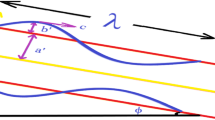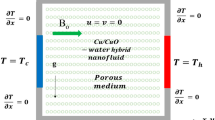In this paper, the authors have simulated pressure wave propagation in a closed system, considering the virtual mass force on the interphase border, the viscous shear force, the slippage velocity, and the narrow drag conditions. Based on the gas-liquid momentum conservation and mass conservation principles, the two-fluid model is established. To solve the model, considering the small disturbance principle and ignoring the second-order items, the basic equations are converted into vector form, and the final equation of velocity is obtained. The model is solved by the software program. The results show that with increase in porosity and decrease in the system pressure, temperature, and density of the liquid phase, the pressure wave propagation velocity decreases. With decrease in the low-frequency angular frequency, the slip velocity, and other factors that can slow down the gas-liquid exchange rate, the pressure wave velocity also decreases. With increase in the incompressibility of the gas-drilling fluid system and decrease in the interphase exchange time, the pressure wave propagation velocity increases. When the pressure wave frequency is low, the wave velocity is restricted mainly by the mechanical characteristics of the phase and the mechanism of thermodynamic balance.



Similar content being viewed by others
References
G. B. Wallis, One-Dimensional Two-Phase Flow, McGraw-Hill, New York (1969), p.143.
D. L. Nguyen, E. R. F. Winter, and M. Greiner, “Sonic velocity in two-phase system,” Int. J. Multiphase Flow, 7(3), 311- 320 (1981).
L. Y. Cheng et al., “An analysis of wave propagation in bubbly two-component two-phase flow,” ASME J. Heat Transf., 107, 402-404 (1985).
A. E. Ruggles et al., “An investigation of the propagation of pressure perturbations in bubbly air/water flows,” ASME J. Heat Transf., 110(5), 494-498 (1988).
S. J. Lee et al., “Pressure wave speeds from the characteristics of two fluids: two-phase hyperbolic equation system,” Int. J. Multiphase Flow, 24, 855-864 (1998).
M. S. Chung et al., “Effect of interfacial pressure jump and virtual mass terms on sound wave propagation in the two-phase flow,” Sound. Vibr., 244(4), 717-728 (2001).
L. Liu, Y. Wang, and F. Zhou, “Study on pressure wave propagation velocity of gas-liquid two-phase flow,” Chin. J. Appl. Mech., 16(3), 47-53 (1999).
F. Huang, B. Bai, and L. Guo, “Mathematical model and numerical simulation of pressure wave for gas-liquid bubble flow in horizontal pipe,” (in Chinese), Prog. Nat. Sci., 14(4) 344-349 (2004).
B. Bai, F. Huang, and X. Wang, “Experimental study on pressure wave dispersion characteristics of gas-liquid two-phase flow,” J. Eng. Thermophys., 26(3), 455-458 (2005).
B. Ergen, Y. Tatar, and H. O. Gulcur, “Time frequency analysis of phonocardiogram signals using wavelet transform: a comparative study,” Comput. Methods Biomech. Biomed. Eng.,15(4), 371-381 (2012).
Acknowledgment
The study has been performed within the framework of the project “Integration and test of quick drilling and completion technologies in the south Junggar and Mahu key areas” (project No.2019F-33), supported by the scientific research and technological development fund (CNPC).
Author information
Authors and Affiliations
Corresponding author
Additional information
Translated from Khimiya i Tekhnologiya Topliv i Masel, No. 4, pp. 82–85, July–August, 2021.
Rights and permissions
About this article
Cite this article
Shi, J., Dang, W., Jiang, Z. et al. Influence of Sensitive Parameters on Pressure Wave Velocity of Gas Drilling Fluid. Chem Technol Fuels Oils 57, 672–675 (2021). https://doi.org/10.1007/s10553-021-01292-1
Published:
Issue Date:
DOI: https://doi.org/10.1007/s10553-021-01292-1




